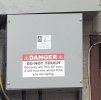Nathan the Machinist
KnifeMaker / Machinist / Evil Genius
Moderator
Knifemaker / Craftsman / Service Provider
- Joined
- Feb 13, 2007
- Messages
- 18,281
Nice!
What size tank will you do?
Will you do auto or manual transfer switch?
It has a little 12 gallon tank on it and an auxiliary pump to run from an external tank. I'll probably get a tank for it, 200 gallons or so. At first I was thinking about something like one of those home heating oil tanks. But I'm seeing some transfer tanks that are mounted on a skid that I could load on a truck and take up the road to get filled, I might do that, I haven't decided.
They make an automatic power transfer kit for these, but I think I'll do a manual transfer. No need to make it complicated.




